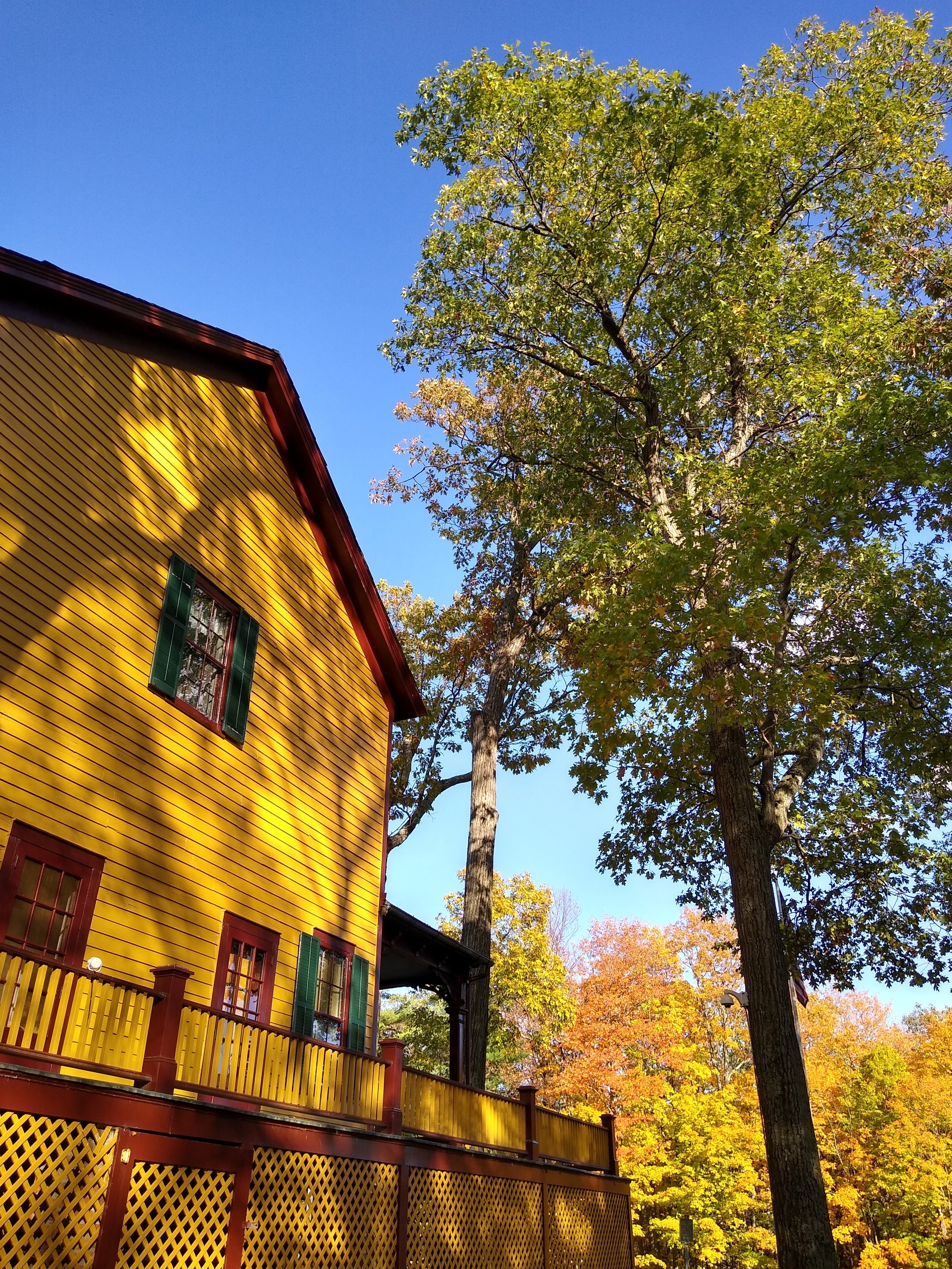Fall view of Grant Cottage.
When one first approaches Grant Cottage on Mount McGregor the first impression is of a brightly colored building tucked into a stand of stately oaks and pines. The mountain on the southeast edge of the Adirondack Mountains of New York boasts a variety of tree species, teeming with birds and small animals. From a Pileated Woodpecker boring a hole to a clambering porcupine chewing on some young bark and twigs high up in the canopy, many animals rely on the forest for survival. The mountain’s trees shaded Ulysses S. Grant as he traveled along the forest paths in 1885, they drew countless Victorian-era resort visitors to their restorative coolness and provided idyllic picnic grounds for patients of the sanitarium in the early 20th century. Trees in innumerable ways have played a key role in the history of the mountain and its inhabitants.
View of a forested Mount McGregor in the 1880s.
In the early 1870s Duncan Mcgregor had established a sawmill on the mountain that would soon bear his name. Mount Mcgregor was a heavily forested ridge of mixed hardwood and conifer trees. Some timber from the mountain was used for construction in the growing communities of the mostly deforested agricultural valley below. McGregor cleared some forest and used the lumber to build a small mountain resort with lofty views but left sufficient tree cover to provide the cool shade and pine-scented air that would attract visitors. McGregor’s modest resort was described in 1878 as being “surrounded by a second growth of timber, — pine, chestnut, oak, beech, maple, and birch, trimmed and cleared of underbrush.”
The forested grounds of the Victorian resort on Mt. McGregor (Grant Cottage on the right).
Thousands of visitors flocked to the mountain seasonally to enjoy the wilderness experience as the resort facilities expanded over the next two decades. Some modern visitors assume there were fewer trees on the grounds during the resort era, but photographs and descriptions instead reveal a shaded mountain paradise. Of the expanded resort on Mt. McGregor in the 1880s one newspaper article claimed that “enterprises of this character will go far toward protecting from destruction the natural beauty and attractions” and was designed not “to interfere with the natural wildness of the scene” so that “all the charms of the wild woods are carefully preserved.” In 1882 Irish poet Oscar Wilde visited the mountain resort and was enamored by the “beautiful surroundings” including the “beautiful trees.” U.S. Grant’s 9-year-old granddaughter recalled the magic of the forest she experienced during their family’s stay in 1885:
““I liked the sunlight coming through high oaks with their moving leaves, and I spent much leisure looking up into them as they whispered among themselves. It is the first time I remember feeling any appreciation of Nature.””
A tall oak towering over Grant Cottage.
— Julia Grant Cantacuzene (U.S. Grant's Granddaughter) Julia Gazebos, benches, and other structures featured the rustic Adirondack “Great Camp” style of architecture that was designed to harmonize with the surrounding forest. During this time, the Adirondack Forest Preserve (later Adirondack Park) was created after state surveyor Verplanck Colvin convinced New York lawmakers that denuding the region would lead to catastrophic flooding and disruption of commerce. The major resort hotel on Mt. McGregor burned in 1897, leaving the mountain, except the cottage where Ulysses S. Grant died, to return to nature.
Victorian resort visitors enjoy the shade of a rustic Adirondack gazebo at the Eastern Overlook on Mt. McGregor.
A wood fire tower on Hunter Mountain in 1909.
The main threat that remained on Mt. Mcgregor was that of wildfire. Major fires, some started by trains igniting logging debris, burned vast swaths of the Adirondack forest in the first two decades of the 20th century. In the spring of 1903 the great Adirondack Fire raged through 600,000 acres of forest in upstate New York and by early June the flames reached a point close enough to threaten Grant Cottage itself. The fires were extinguished but within a decade the state was installing fire towers throughout the region staffed by observers to promptly report forest fires.
Article headline from The Pokeepsie Evening Enterprise, Nov. 11, 1908
The remaining vestiges of the resort decayed in the first decade of the 20th century and the property transferred hands. In the fall of 1908, concerns were raised about the potential loss of forested land on Mt. McGregor. One newspaper warned that the "valuable timber land which for many years past have furnished the picnic grounds for thousands of people, will gradually dwindle away" under the lumberman’s axe. The following year there were calls for the State of New York to purchase the land to prevent the harvesting of the timber and to establish it as a state park. The effort was touted as a "patriotic effort" to preserve the scenic surroundings of the historic memorial to Ulysses S. Grant.
Conservation of forests fell under a few justifications during this time. The value of the forests was measured by some mostly as a commodity while others argued for their ecological, recreational, and aesthetic value. The United States Forest Service was established in 1905 to, among other duties, protect the national forests from illegal timber harvest and wildfires. It seems the concerns about Mt. McGregor mainly fell into the aesthetic, ecological, and recreational realm.
In 1910, before the concept of establishing a state park could become a reality, the Metropolitan Insurance Company bought land on the mountain and created a Sanitorium, predominantly for tuberculosis patients. Acres of trees were felled to make way for the campus which housed hundreds of patients and staff, but aside from this, the remaining forest was left untouched. In fact, in 1922, the Conservation Commission monitored the planting of 18,500 trees on the mountain, part of a larger effort totaling over a million in the county. Over the next few years, thousands of species were planted on the mountain by the staff of the sanitorium including Northern spruce, European larch, White pine, and White cedar. This was part of a larger statewide initiative made possible by legislation such as the Free Tree Bill of 1920 which encouraged reforestation efforts in the 1920s-30s.
European larches (a conifer that loses needles) in late fall on Mt. McGregor.
Sanitarium patients hosting a Mt. McGregor County Fair under the shade of the trees.
Wildfires continued to pose a significant threat to the forest and facilities on the mountain with one nearly reaching the sanitorium in the spring of 1930. Over the next 45 years, the mountain facility hosted veterans before being converted into a center for individuals with developmental disabilities. In 1976 the site was once again slated to become a state park with plans to tear down over 40 buildings and restore the natural setting. Once again it was not to be as the New York State Department of Corrections (DOCCS) claimed the facility instead and converted it into a minimum/medium-security prison which operated for the next four decades. At times the inmates played a role in fighting wildfires in nearby forests.
Fall colors of a maple tree on Mt. McGregor
After the closure of the prison in 2014, 750 acres of wooded land surrounding the facility were transferred from DOCCS to the New York State Office of Parks and incorporated into the existing Moreau Lake State Park. Over 40 mostly forested acres were transferred to Grant Cottage State Historic Site.
In addition to the thousands of acres of woodland preserved within Moreau Lake State Park, there is a conservation vision for the entire Palmertown Range being led by the local land conservation group Saratoga PLAN. Their goal is to balance recreational use with the preservation of the ecosystem. As development continues in the valley below, the preservation of the Palmertown Range as a wildlife habitat and corridor becomes ever more essential. Since the Victorian era, promoters of the mountain have never failed to tout the physical benefits of its natural environment. In 1885 U.S. Grant’s physician said of the mountain that “above all, it is among the pines, and the pure air is especially grateful to patients suffering as General Grant is.” Now referred to as “forest bathing,” the practice of immersing oneself in nature for psychological and physical benefits is a popular activity with regular group outings available through Moreau Lake State Park.
A forested path on Mt. McGregor.
A number of trees were removed in 2020 from a hillside near the Grant Cottage Visitor Center. Normally, mature tree removal would be avoided, but there was a justification for such an action. Grant Cottage Historic Site made a significant move into the realm of sustainable infrastructure when an off-grid solar power system was installed at the site in 2021. Although solar panels are more efficient than trees at reducing carbon emissions, reforestation remains a viable alternative in mitigating the harmful effects of climate change.
Cedar and Spruce trees on Mt. McGregor.
Today there is a mixture of forest types on the slopes and plateau of the Palmertown Range that Mt. McGregor is a part of. The two most prominent forest types are Hemlock-Northern Hardwood and Oak-Pine. Some of the trees planted as part of reforestation efforts in the early 20th century are still evident on the road that ascends the eastern slope of the mountain. The larches stand out in the fall as their needles change color, while the spruces towering by the roadside are heavily laden with their large cones. The trees tell their own story of life on the mountain with twisted branches and other evidence of enduring strong mountain weather. Visitors to the mountain can find history preserved in the cottage, but can also come to appreciate the trees not just as part of the natural setting, but as part of the mountain’s history preserved as well.
Find out more about Arbor Day here:
Sources:
Forests for the People - by Diane Galusha - New York Archives magazine - Spring 2012
Adirondack Daily Enterprise, April 16, 1976
The Nature Conservancy Northeast Habitat Map
The Captain Departs by Thomas Pitkin















